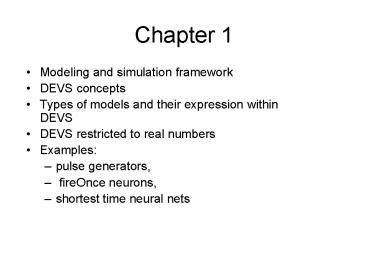Modeling and simulation framework - PowerPoint PPT Presentation
1 / 12
Title:
Modeling and simulation framework
Description:
Chapter 1. Modeling and simulation framework. DEVS concepts ... step by step, brick by brick. swimmers strokes. how fast, how far, how soon. don't interrupt ... – PowerPoint PPT presentation
Number of Views:45
Avg rating:3.0/5.0
Title: Modeling and simulation framework
1
Chapter 1
- Modeling and simulation framework
- DEVS concepts
- Types of models and their expression within DEVS
- DEVS restricted to real numbers
- Examples
- pulse generators,
- fireOnce neurons,
- shortest time neural nets
2
Basic Entities and Relations in Modeling and
Simulation
Experimental Frame
Source
Simulator
System
behavior database
Modeling Relation
Simulation Relation
Model
3
Discrete Event Time Segments
X
t1
t0
t2
S
e
y0
Y
4
DEVS Introduction Phrases
- faithfully yours
- step by step, brick by brick
- swimmers strokes
- how fast, how far, how soon
- dont interrupt
- together we can do it!
- the instant manager
- crossing the threshold, testing the limits
- when to say when (acceptor)
- let others have a chance (refractoriness)
- plotting in real time
5
DEVS Hierarchical Modular Composition
- Atomic lowest level model, contains structural
dynamics -- model level modularity
SimpArc.efa
Coupled composed of one or more atomic and/or
coupled models
hierarchical construction
coupling
6
DEVS Atomic Model
Elements of an atomic model
pulseModels. basicGenr
- input events
- output events
- state variables
- state transition functions
- output function
- time advance function
7
Atomic Model Operation
- Ports are represented explicitly there can be
any number of input and output ports on which
values can be received and sent - The time advance function determines the maximum
lifetime in a state - A bag can contain many elements with possibly
multiple occurrences of its elements. - Atomic DEVS models can handle bags of inputs and
outputs. - The external transition function handles inputs
of bags by causing an immediate state change,
which also may modify the time advance. - The output function can generate a bag of outputs
when the time advance has expired. - The internal transition function is activated
immediately after the output function causing an
immediate state change, which also may modify the
time advance. - The confluent transition function decides the
next state in cases of collision between external
and internal events.
8
DEVS Atomic Model Implements Basic DEVS
Make a transition (internal)
Make a transition (external)
input
State
internal
external
time advance
Handle input
output
output
Hold for some time
Send an output
pulseModels. fireOnce Neuron
9
Atomic Model Examples
pulse
Pulse Generator
time
interPulseTime gt0
Pulse Generator
Output
pulseExpFrames. pulseGenr
start
ta 8
Output
Fire-once Neuron
Input
Firing delay gt0
pulseModels. fireOnceNeuron
ta 8
ta 8
external event
Internal event
output event
10
Internal Transition /Output Generation
using the output function
using the internal transition function
11
Response to External Input
using the external transition function
elapsed time
Time advance
12
Response to Simultaneous External Input and
Internal Event
elapsed time
using the confluent transition function
Time advance































